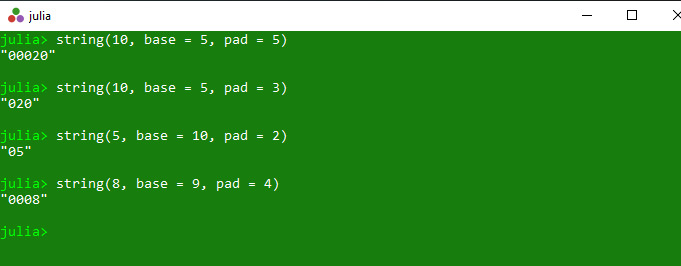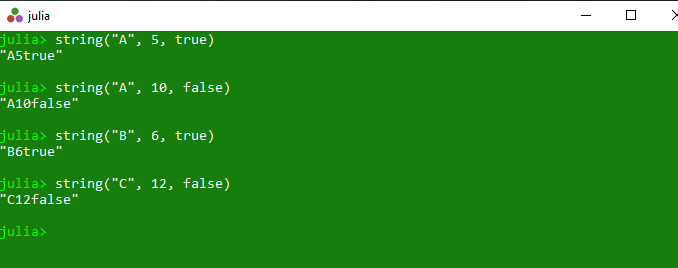string()是 julia 中的内置函数,用于将指定的整数转换为给定基数的字符串。
用法:
string(n::Integer; base::Integer, pad::Integer)
参数:
- n::Integer:指定的整数。
- base::Integer:将在其中执行转换的指定基数。
- pad::Integer:它是返回的字符串中存在的字符数。
返回值:它以给定的基数返回转换后的字符串。
范例1:
Python
# Julia program to illustrate
# the use of String string() method
# Conversion of integer to a string
# in the given base
Println(string(10, base = 5, pad = 5))
Println(string(10, base = 5, pad = 3))
Println(string(5, base = 10, pad = 2))
Println(string(8, base = 9, pad = 4))输出:

:
范例2:
Python
# Julia program to illustrate
# the use of String string() method
# Creation of a single string using
# all the arguments
Println(string("A", 5, true))
Println(string("A", 10, false))
Println(string("B", 6, true))
Println(string("C", 12, false))输出:

相关用法
- Julia sizeof()用法及代码示例
- Julia reverse()用法及代码示例
- Julia findlast()用法及代码示例
- Julia length()用法及代码示例
- Julia repeat()用法及代码示例
- Julia SubString()用法及代码示例
- Julia findfirst()用法及代码示例
- Julia replace()用法及代码示例
注:本文由纯净天空筛选整理自Kanchan_Ray大神的英文原创作品 Convert an Integer to a String in Julia – string() Function。非经特殊声明,原始代码版权归原作者所有,本译文未经允许或授权,请勿转载或复制。
